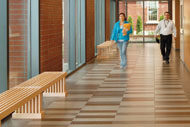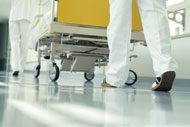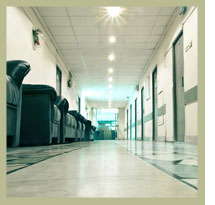 Because flooring makes a significant impression on hospital visitors, it is important to devote time and attention to the appearance of this portion of the property. Approximately 60 percent of a property's maintenance expense is attributed to its flooring.
Because flooring makes a significant impression on hospital visitors, it is important to devote time and attention to the appearance of this portion of the property. Approximately 60 percent of a property's maintenance expense is attributed to its flooring.
Thus, putting in place a comprehensive plan for its upkeep — whether it is carpet, tile, stone, vinyl composition tile or a combination — not only improves the guest experience but also serves to manage this large expense item. Implementing a floor care maintenance program results in the further benefit of increasing the longevity of the assets, thereby lowering capital expenditures.
Four key components
With guidance from the trade association Carpet and Rug Institute (CRI), we have developed the following four key components of comprehensive commercial carpet and tile and grout care:
1. Preventative measures. Hospitals focus tremendous effort on maintaining clean floors inside their property, but some attention should also go towards preventing dirt and debris from entering the building in the first place. Careful usage of entranceway mats can help, especially in winter months.
An effective approach begins outside the property. Scraper-type mats remove the largest size dirt and grit attached to shoes and boots. Next, immediately inside the entryway a well-positioned natural or grass mat absorbs moisture and smaller dirt particles. Lastly, a fiber mat placed deeper into the property traps some of the remaining soil and moisture before they come into contact with the hard floor surface.
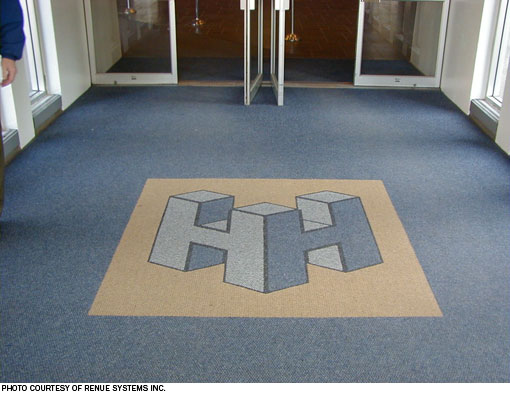 |
| A series of walk-off mats is an essential preventive floor care measure. |
In addition to the type and placement of the mats, consideration should be given to their length. According to the American Institute of Architects, 5 feet of matting will capture 33 percent of external soil entering a venue, 10 feet will capture 52 percent, 20 feet will capture 86 percent and 25 feet will capture nearly all the soil.
Once they are filled to capacity with dirt and debris mats become counter-productive. Thus, mats should be cleaned regularly to maintain maximum effectiveness. This can be accomplished by vacuuming, laundering and replacing mats at various times and by having extra mats available when one set is being cleaned.
2. Frequent housekeeping. Nothing beats regular vacuuming to reduce the soil load in carpet. In fact, an estimated 75 percent of the performance of carpet cleaning is in the vacuuming, so thorough, routine vacuuming is essential for solid carpet care.
Walking on soiled carpeting allows dirt particles to work their way below the surface of the pile where they are far more difficult to remove and can even damage the carpet fibers. For light soil loads, three passes of the machine suffice, but five to seven are necessary for heavily soiled areas. Changing the vacuuming direction occasionally increases effectiveness.
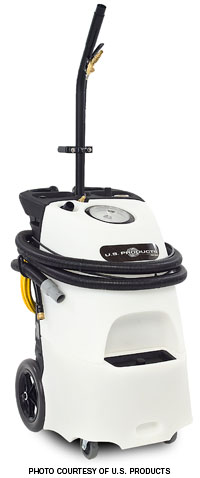 |
| Periodic deep cleaning must be scheduled to remove residues and trapped soil. |
Key vacuuming components include the following:
•Machine selection. An inexpensive machine may remove surface dirt but will not effectively remove the hidden dirt and particles embedded in the pile. For the specific model, we advise consulting with the carpet manufacturer for its recommendation, taking into consideration the type of carpet. There are good quality environmentally sensitive vacuum cleaners on the market. For a list, refer to CRI's Green Label Approved Vacuum machines. Also, consider using HEPA vacuum bags. They are well-suited for allergy sufferers because they filter out almost all dust and pollens.
Vacuum manufacturers like to boast about the strength of their machines by promoting horsepower and amperage. What is more important is to focus on suction and airflow. A good machine is geared toward high performance on one of these metrics, depending on its intended usage. In general, for addressing liquid clean-ups it is best to use equipment with strong suction (such as 150 inches). Conversely, a vacuum with a high airflow (such as 156 cubic feet per minute) is well suited for removing dry soil.
•Frequency. A carpet or rug should be vacuumed anywhere from two to three times per week to at least daily, depending on such factors as the amount of foot traffic, the location of the carpet and its visibility.
•Equipment operation and maintenance. Parts such as beater bars and belts should be checked regularly for wear. Also, bags should be changed to maximize suction. A machine should only be operated and maintained according to the manufacturer's specifications.
Similarly, hard surfaces should not be neglected. One common surface — tile and grout — can be mopped a minimum of several times each week and in some cases more frequently. Tile is fairly easy to keep clean, and it can be done so with a mild detergent. Grout needs more care due to its porous nature. A stronger detergent and more elbow grease are needed.
3. Spot and spill removal. Remove stains as needed. When doing so, act quickly by treating as soon as possible. The longer the contaminant sits, the more difficult it will be to eliminate, and the more likely it is to become permanent. Many stains should be treated differently, and some actions can make the situation worse. It is advised to follow the manufacturer's recommendations or call an expert to assist.
Ever wonder why stains return almost immediately after eradicating them? When a carpet dries, it does so from the bottom up. Even after the stain is removed, there can still be residual staining below the surface waiting to "wick" back to the surface during the drying process. Aiming an air-mover or carpet fan directly at the stain can reverse the drying process downward.
4. Restorative cleaning. Schedule periodic deep cleaning to remove residues and trapped soil. To improve the aesthetics of the hospital, increase the carpet's longevity and minimize cleaning costs, deep cleaning should be performed before the soil is highly visible. Also of importance — especially in venues with food — is the need to address the accumulation of fats, oils and grease (FOG). They require stronger techniques than vacuuming.
There are several different types of restorative cleaning ranging from hot-water extraction to low-moisture methodologies. While the former produces better results, cleaning without water — using an encapsulation or bonnet technique — sometimes can be used when a four- to six-hour dry time is not practical.
Regardless of methodology used, the most critical step is identifying the low, medium and high traffic areas so frequency can best be balanced with limited staff time and equipment. Again, it is prudent to consult the manufacturer's recommendations regarding the specific frequency within the common range of 1 to 12 times per year.
For tile and grout surfaces, the key decision in making the grout lines clean is whether to use an acid-based product or an alkaline-based one for the specific application. Each property can present unique challenges regarding the type of soiling and staining that is affecting the tile and grout. For example, many restaurants and kitchens have FOG that have built up over time and discolored the grout lines. This type of soiling will require a high alkaline product with the right dwell time to remove.
Bathrooms and swimming pool decks can present a whole different set of challenges since these areas have hard water deposits, detergent build, body oils and dead skin that have accumulated over time and polymerized with the soil. An acid-based product is best used in these situations.
There are often dramatic differences in the darkness of grout lines located only short distances apart because they are subject to varying amounts of foot traffic. Especially in a food environment, grout sealer is recommended because it prevents FOGs and dirt from penetrating the porous surface. Where applicable, an impregnator can be used to bring out the natural color.
Enjoying the results
While it may appear overwhelming, once this four-step maintenance plan is put into place, it is simply a matter of working it, occasionally revising it and then enjoying the impressive aesthetic as well as financial results.
David Grossman is president of Renue Systems Inc., Addison, Ill., a provider of specialized cleaning services. He can be reached via e-mail at david.grossman@renuesystems.com.



